Geometry in Medicine
By Caroline, Sarah, Karen and Jessica

Everyone, everyday uses geometry in one form or another. In the field of medicine, geometry helps doctors figure out how to solve certain medical conditions. By looking at how geometry is used in Physical Therapy, Body Performance, and through medical technological advances, we will see how geometry plays a key role in the medical field.
The Use of Geometry in Physical Therapy
The Use of Geometry Through Studies of Body Performance
Hip Angles and the Stepping Efficiency in Children
The Use of Geometry in Technological Advances
The Use of Geometry in Physical Therapy
Physical Therapy is a huge field of study. Today Physical Therapists can help more people now than ever before, and their help is in demand. Technology and medical advances have made it possible for these professionals to meet society’s huge expectations. All of the benefits society reaps from this profession would not be possible without the use of geometry. Without geometry people who are affected by arthritis, strokes, heart disease, and other conditions that require long term care could not be helped. Athletes nowadays have the ability to prevent knee, leg, back, shoulder, and other musculoskeletal injuries sooner than they ever have previously, all because of geometry.
A very impressive example of geometry that is being used in physical therapy to help people was presented in the article “Can Spinal Surgery Be Prevented By Aggressive Strengthening Exercises? A Prospective Study of Cervical and Lumbar Patients”. The study described in the article presents people who may benefit more from a regimen of physical therapy rather than having a spinal surgery performed on their backs. The study takes place in a privately owned clinic, staffed by physicians and physical therapists that specialize in neck and back pain. The study was conducted over two and a half years and each patient had to meet three requirements (Nelson et al. 20). Each patient had to have a physician’s recommendation for the lumbar or cervical surgery, have no medical condition that would restrict exercise, and be willing to participate in an approximately ten week outpatient program (Nelson et al. 20).
Specially designed equipment was used to isolate and then strengthen the spinal musculature, which included the lumbar extensors, cervical extensors, and thoracic rotators (Nelson et al. 21). The lumbar and cervical extensors are muscles that surround the lumbar and cervical vertebrae. The cervical vertebrae and muscles make-up a person’s neck, while the lumbar vertebrae and muscles make-up the lower part of a person’s back. The different kinds of vertebrae are presented in the following picture.
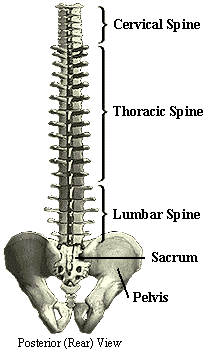
The cervical and lumbar patients each used a differently designed chair to complete their exercises. For cervical patients, the machine was equipped with a cervical extension device that allowed for a 126-degree angle between the extended position of the device and the flexed position of the device (Nelson et al. 22).
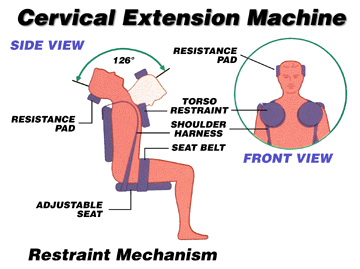
For lumbar patients, the machine was equipped with a lumbar extension device that allowed for a 72-degree angle between the extended position of the device and the flexed position of the device.
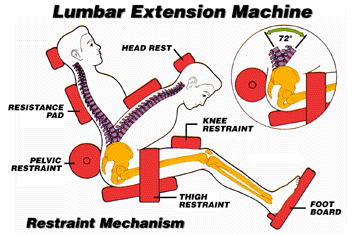
The proper position for either a lumbar or cervical patient using these machines is a fixed torso and a neutral back. A certain weight load was placed on each patient’s machine; weight would then be added to the device at a constant rate over the period of the rehabilitation. On both machines it is possible to set isometric test points every three degrees. This makes it possible to find the optimal range for each patient. This optimal range is key factor in the strengthening of the back, so the angle of the range of motion is very important. The regimen of exercises would continue until the patient could not move his/her back in a certain rotational plane. Each patient was seen twice a week for approximately one-hour. All these activities were supervised by physical therapists (Nelson et al. 21).
The results of the study were encouraging. Forty-eight people out of the sixty people that entered the program actually finished. The average man out of the lumbar extensor patients was able to add 72% of the original weight he started with by the end of the study. The average women was able to add 87%. For the cervical extensor patients in the study, the average man was able to add 61% more weight, while the average women was able to add 65% of the original weight. Only three out of the thirty-eight lumbar patients needed surgery after the study was concluded, while none of the cervical patients needed surgery (Nelson et al. 23).
Not only were people helped physically, they were helped financially. The average cost of the exercise rehabilitation program was $1,950; in comparison, an average worker’s compensation of the lumbar surgical procedure costs $168,000 (Nelson et al. 24). The surgery is eighty-six times more expensive than the physical therapy program. This is especially interesting since surgery seemed to happen in a few isolated cases in this study. Cost effectiveness is a huge reason to consider physical therapy, because low back disease ranks third as a reason for surgical procedures overall (Nelson et al. 20). Geometry is a factor in making people feel better at a much cheaper cost than surgery. This is just one area of Physical Therapy in which geometry is used. It is prevalent in other areas too. Where would the field of Physical Therapy be without geometry?
The Use of Geometry Through Studies of Body Performance
Geometry can be found in physical therapy related to sport injures. In August, 1989, Dave Dravecky, pitcher for the San Francisco Giants, returned from surgery after 10 months of recuperation. Dravecky had a desmoid tumor removed from his pitching arm. Which included the removal of most of his deltoid muscle and cryosurgery of the humerus. Cryosurgery is the insertion of a probe, chilled with liquid nitrogen, into the tumor. The tumor is killed by freezing it (Health Watch 1). Soon after his return to pitching, Dravecky sustained a spiral fracture of his humerus.
Where does the geometry come in?, you may ask. According to Schachter et. al., 1992, it is the geometry of the bone structure that gives the bone its torsional and bending strength. The cross-sectional area of bone and the distribution about the rotational and neutral axes affects the strength. These terms relate to the strength of the bone structure and are both directly dependent on the factor ro4-ri4, where ro and ri are the external and internal radii of the bone (see figure). Changes in the radius have a large impact on the strength of the bone. The small decrease in Dravecky’s external humeral radius could have decreased the strength of his humerus bone.
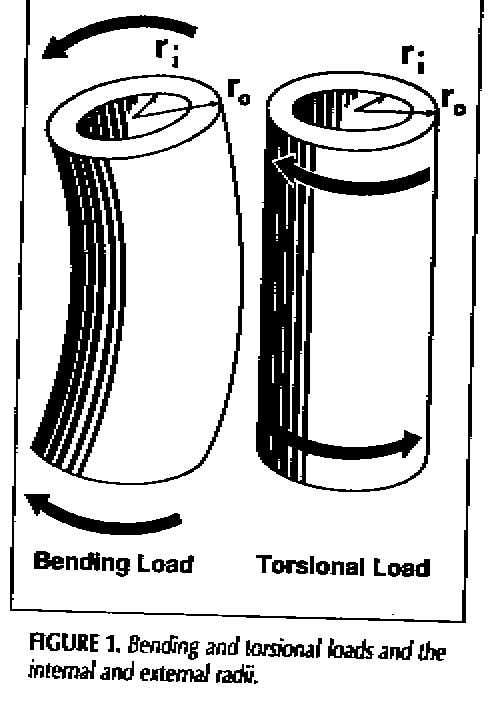
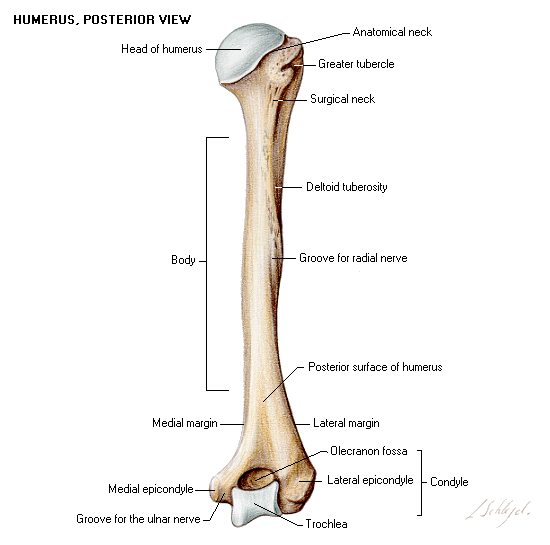
There are many other factors that could have led to the fracture of Dravecky’s humerus bone. They may include fatigue in the bones due to the time off, the effects of the cryosurgery, and an increase in stress caused by the decrease in the radius of the humerus. The purpose of that article was to inform athletes of the dangers of returning too soon after injury or surgery (Schachter et al. 3).
On the same note, there are many female athletes that suffer from torn anterior cruciate ligaments, ACL’s. The number of girls with this knee injury is much larger than the number of boys. This is due to many different factors. The first could be due to the fact that girl’s hips are wider, causing the upper leg to connect at a greater angle, possibly putting more strain on the joint. Another could be because girls are more flexible than boys, making the knee less stable.
There is not much that girl’s can do about the width of their hips, but they can help with the flexibility. The hamstring is directly related to the ACL. Here is a rule of thumb to decrease the risk of hyperextension of the knee. When lying flat on your back with one leg on the floor, lift the other leg so that it is 90° to the floor. If you can kick beyond 90°, then there is too much flexibility. A way to help the strength of the hamstring is a strength-training program that works not only the hamstring but also the entire leg (Lambert 1).



